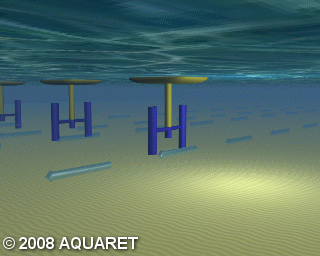Tidal Energy - Devices
Types of devices
Horizontal Axis Tidal Turbines (HATT) have a design that can be compared to horizontal axis wind turbines, the difference being that the energy is converted from a water flow instead of an air flow. Importantly, water has about 800 times the density of air. Marine energy is a very powerful resource and so a low-current speed can still be useful. The turbine has to face the currents in order to produce electricity, and that is why a bidirectional turbine design is preferable. It is the most common tidal turbine design. Variations between HATT designs can include the turbine size, number of blades, shape of blades, etc.




Vertical Axis Tidal Turbines (VATT) rotate around a vertical axis in the same fashion as vertical axis wind turbines. This device works with currents coming from any direction. It is, with the vertical axis tidal turbine, a popular design.




Oscillating Hydrofoil devices consist in a foil attached to the tip of a mobile arm. Currents will exert pressure on the foil, forcing it to ascend and descend in an oscillating motion. Electricity is produced through an hydraulic system.




Mooring Systems
Gravity base devices are heavy enough to remain fixed on the seabed without any extra attachments.
The main advantage of this design is that, if the water is deep enough, it allows safe navigation above the device.
The main advantage of this design is that, if the water is deep enough, it allows safe navigation above the device.
Pole mounted devices are attached to a pole that has been fixed to the seabed.
Such mooring allows easy maintenance if the turbine/device can be lifted. This design can be advantageous if horizontal axis turbines are able to rotate around the pole in order to face the currents.
Such mooring allows easy maintenance if the turbine/device can be lifted. This design can be advantageous if horizontal axis turbines are able to rotate around the pole in order to face the currents.
Floating platforms are the easiest install and maintain, but also need more sea-surface area which can disrupt navigation. It is possible to have a flexible mooring that would allow the platform and the device to turn and face the currents (using more sea surface area), or a more rigid mooring, fixing the platform in a certain position (saving more sea surface space).





